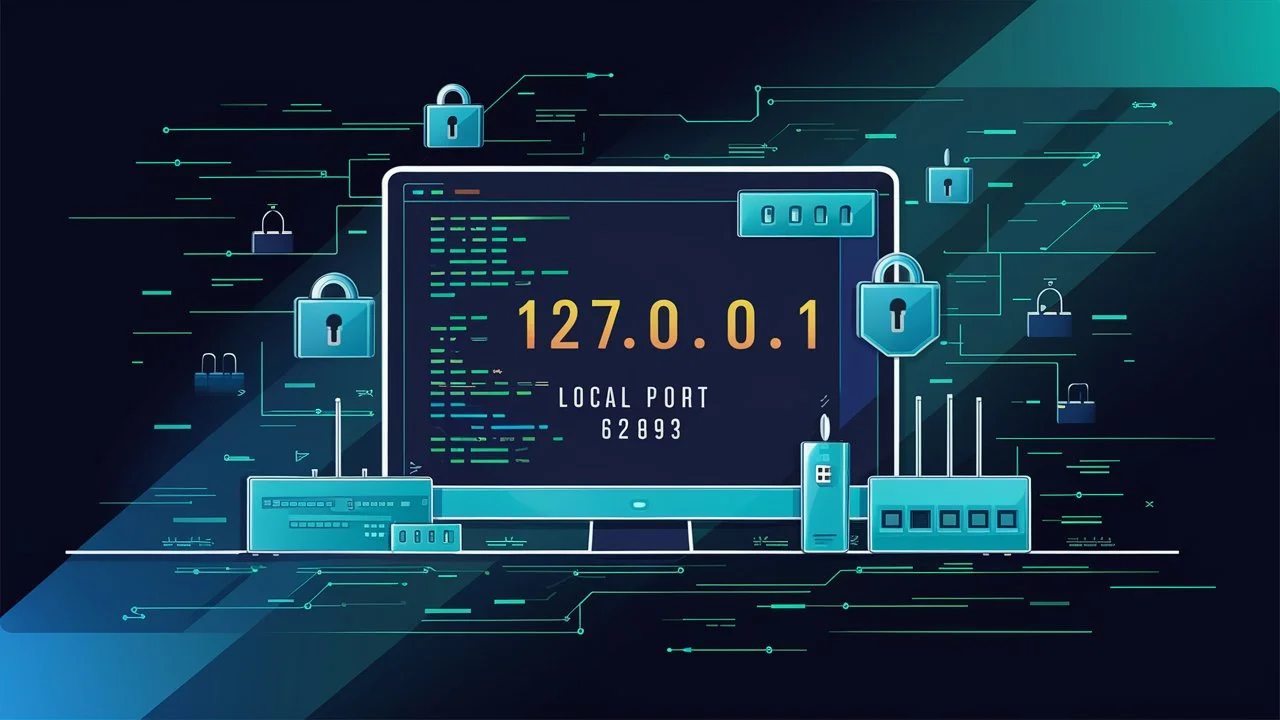1. Introduction to 127.0.0.1:62893
At first glance, “127.0.0.1:62893” might look like a jumble of numbers, 127.0.0.1:62893 but in reality, it plays a fundamental role in the world of networking. If you’re familiar with computers, networks, or web development, you’ve likely encountered these numbers, especially in the context of localhost testing or software configuration. In simple terms, 127.0.0.1 refers to the localhost, a loopback address used in networking to refer to the device you’re currently using, while 62893 is a port number.
While this combination might seem random, it’s essential to understand what each part represents and how they work together to facilitate local network communication. Throughout this article, we’ll explore what 127.0.0.1:62893 means, why it’s important, and how it’s used in various networking scenarios, from web development to application testing.
2. Understanding the Concept of Localhost (127.0.0.1)
The IP address “127.0.0.1” is often referred to as the “localhost.” It’s a special address used to establish an IP connection to the same machine or computer being used by the end user. Essentially, when you communicate with 127.0.0.1, you’re communicating with your own device.
The idea behind localhost is simple: it allows software on your computer to communicate with itself via a network interface, without involving any external networks or devices. This feature is critical for testing web applications, development environments, and network-related services without exposing them to the outside world.
When you enter “127.0.0.1” in your browser’s address bar or access it through a terminal, your system treats it as a loopback request, sending the data to itself. This can be particularly useful for debugging, testing, or hosting applications locally. Whether you’re running a website on a local server or testing network connectivity, 127.0.0.1 is your go-to address for staying local.
3. What Does Port 62893 Represent?
In the world of networking, port numbers act like channels through which data flows between devices. A port number combined with an IP address like 127.0.0.1 forms a socket, a virtual door through which network communication occurs.
Port 62893 is one of many port numbers that can be assigned to a process or service on your machine. In this case, it’s likely a randomly assigned port used for development or debugging purposes. The port range is vast (from 0 to 65535), and many of these ports are dynamically assigned by your operating system when needed, especially for local services.
So, what’s special about 62893? Nothing, per se, except that it’s a port number that may be assigned to a specific service running locally. Developers, testers, and engineers frequently work with such port numbers when setting up applications, managing databases, or configuring web servers. This combination of 127.0.0.1:62893 is often seen when running development tools or applications locally for testing.
4. How Networking Protocols Work with 127.0.0.1
When discussing IP addresses and ports, it’s essential to understand how networking protocols come into play. The two most common protocols used with localhost are TCP (Transmission Control Protocol) and UDP (User Datagram Protocol). Both have their unique advantages and use cases.
When you’re working with 127.0.0.1, TCP is often the default choice. It’s reliable, ensures data packets are sent in order, and confirms receipt of each packet. If you’re hosting a web server or database locally on 127.0.0.1, you’re likely using TCP.
UDP, on the other hand, is connectionless and doesn’t guarantee delivery of packets, which makes it faster but less reliable. However, for many local applications, reliability is paramount, which is why TCP is often the go-to choice when working with localhost addresses like 127.0.0.1.
For example, when you run a local development environment or test server on your machine, the software communicates with itself via these networking protocols using the loopback IP address 127.0.0.1 and a specific port (like 62893).
5. The Role of Ports in Network Communication
Ports are essential in distinguishing between different services running on the same device. Think of them as virtual “doors” that allow various applications to communicate with the network independently of each other.
When you run multiple services on the same machine, such as a web server and a database, they each need their own port. For instance, your web server might run on port 8080, while a database might use 3306. Port 62893, as we see in the context of 127.0.0.1:62893, could be assigned to any number of processes, like a local development server or debugging tool.
Port numbers below 1024 are typically reserved for well-known services (like HTTP on port 80 or HTTPS on 443), while ports above 1024 are often dynamically allocated for custom services or internal application communication. That’s why you’ll often see port numbers in the higher ranges, like 62893, used for local testing and development purposes.
Understanding port usage is key to troubleshooting network issues, managing system resources, and ensuring applications can communicate effectively without interfering with each other.
6. How to Access 127.0.0.1:62893 and Why You Might Want To

Accessing 127.0.0.1:62893 is quite simple. All you need to do is open your browser or terminal and enter “http://127.0.0.1:62893” (assuming the service you’re trying to reach is using HTTP). This address will route you to whatever service is running on your local machine at port 62893.
Why would you want to access it? Localhost is incredibly useful for developers, testers, and engineers. It allows them to run services, applications, and databases locally without the risk of exposing them to the public internet. This setup is ideal for development, as it provides a controlled environment to test and troubleshoot before launching a project or application to production.
By accessing 127.0.0.1:62893, you’re likely connecting to a locally hosted application or service running on port 62893, such as a local web server, API, or custom-built software. This is particularly useful during the development phase of an application, where testing in a local environment can speed up debugging and optimization.
7. Practical Examples of Using 127.0.0.1:62893
Let’s dive into a few practical examples where 127.0.0.1:62893 might be used in real-world scenarios:
- Local Web Development: Imagine you’re developing a website using a framework like Node.js or Django. When you run the server locally, it might be assigned to port 62893. By entering 127.0.0.1:62893 in your browser, you can see how the website behaves before deploying it live.
- API Testing: If you’re building or consuming an API, you might run it locally for testing. Tools like Postman or cURL can interact with APIs hosted on 127.0.0.1:62893, allowing you to test requests and responses in a safe environment.
- Database Management: A local database management tool, such as MySQL or PostgreSQL, might be hosted on 127.0.0.1 with a random port like 62893. Accessing this address allows you to interact with the database, run queries, or manage data without needing to connect to an external server.
These examples highlight just a few use cases where localhost and port numbers come into play, demonstrating how vital this functionality is in day-to-day development tasks.
8. Common Applications That Use 127.0.0.1 and Random Ports
There are numerous applications and services that utilize 127.0.0.1 for local testing and development, often combined with random or specified port numbers. Here are a few examples:
- Web Servers: Tools like Apache, Nginx, or even local web servers created with Node.js will often bind to 127.0.0.1 during development, assigning a random or predefined port for local testing.
- Database Systems: Systems like MySQL, PostgreSQL, or MongoDB typically bind to localhost for administrative tasks or local database management. They may also run on random ports depending on how they’re configured.
- Integrated Development Environments (IDEs): Many IDEs, such as Visual Studio Code, have built-in servers that run on localhost with dynamically assigned ports. When you preview a project, you’re likely interacting with an address like 127.0.0.1:62893 behind the scenes.
- Virtual Machines and Containers: Tools like Docker or Vagrant often expose services running inside containers or virtual machines to localhost. This allows the user to interact with these services as if they were running natively on their machine, without requiring external IP addresses.
Each of these applications relies on localhost functionality to ensure safe, efficient, and isolated testing environments.
9. Troubleshooting Issues with 127.0.0.1:62893
Despite its simplicity, localhost communication can sometimes present problems. Here are a few common issues you might encounter when working with 127.0.0.1:62893 and some tips on troubleshooting:
- Service Not Running: One of the most common issues is that the service you’re trying to access on port 62893 simply isn’t running. Double-check that your application or service has been correctly started and is bound to the right port.
- Port Conflicts: If another service is already using port 62893, your new service won’t be able to bind to it, resulting in errors. In this case, you’ll need to either stop the conflicting service or assign a different port to your application.
- Firewall or Security Settings: Although 127.0.0.1 traffic stays local to your machine, firewall rules or security settings may block access to certain ports. Check your system’s firewall or security software to ensure it isn’t preventing access to port 62893.
By understanding these potential pitfalls, you can ensure smooth operation when working with localhost and ports.
10. Security Concerns with Localhost and Ports
Although 127.0.0.1 is isolated from external networks, security should still be a concern, especially if you’re working with sensitive data or critical applications. Even though traffic on localhost doesn’t leave your machine, it’s important to follow best practices for security.
For instance, leaving unnecessary services running on localhost could expose you to risks, particularly if those services have security vulnerabilities. While it’s less likely for an external attacker to exploit services on localhost, internal threats or misconfigured systems could create vulnerabilities.
Ensuring that ports like 62893 are properly managed and closed when not in use, using strong authentication and encryption for services running on localhost, and regularly updating software to patch known vulnerabilities are all critical steps in safeguarding localhost traffic.
11. The Importance of Firewalls in Protecting Localhost Ports
Firewalls play a crucial role in managing and securing network communication, even on localhost. A firewall can be configured to block or allow traffic on specific ports, adding an extra layer of protection against potential threats.
When running services locally, firewalls ensure that only authorized applications can access specific ports. For example, if you have a service running on 127.0.0.1:62893, your firewall might be configured to allow only your browser or terminal to communicate with that port, preventing unauthorized access.
Additionally, a firewall can help prevent port scanning attacks, where malicious actors probe your system for open ports that they can exploit. Even though localhost ports are generally not exposed to the internet, having a firewall adds another level of security in protecting sensitive applications and data.
12. Real-World Scenarios Where You Might Encounter 127.0.0.1:62893
While many use localhost for development purposes, there are several real-world scenarios where you might encounter 127.0.0.1:62893 or a similar address:
- Software Testing: Before releasing software to the public, developers often run tests on localhost to ensure everything works as expected in a controlled environment. This prevents bugs and security flaws from appearing in production.
- Local Hosting for Personal Projects: If you’re running a website or app just for personal use, you might not want to deploy it to the internet. Instead, you can host it locally on 127.0.0.1 with a custom port like 62893.
- Debugging Tools: Debugging software often runs on localhost with dynamically assigned ports. For example, when running a Python debugger or using a JavaScript debugging tool, you might access it through an address like 127.0.0.1:62893.
By understanding the role of localhost in these scenarios, you can better appreciate its value in both development and personal use cases.
13. How Developers Use 127.0.0.1:62893 for Testing
Developers rely on localhost extensively during the development and testing phases of a project. Whether they’re building a web application, testing API endpoints, or debugging software, localhost provides a safe and isolated environment.
By running a local web server on 127.0.0.1:62893, for instance, developers can see how their application behaves in real-time. This allows them to make changes, test functionality, and troubleshoot any issues before making the application available to the public.
Localhost is also invaluable when testing new features, ensuring they work as expected without affecting the live version of the software. By using tools like browsers, Postman, or even command-line interfaces to interact with 127.0.0.1:62893, developers can simulate real-world usage scenarios.
14. 127.0.0.1:62893 in Web Development
In web development, 127.0.0.1:62893 is often used when running local servers. Whether you’re building websites with HTML/CSS or using more complex frameworks like React or Angular, having a local environment is key to rapid development.
For instance, when using tools like Node.js, you can easily spin up a local web server bound to 127.0.0.1:62893 and start testing your web pages immediately. This approach is not only faster but also safer, as it prevents untested code from being exposed to the public.
Frameworks like Django (Python) or Rails (Ruby) also encourage developers to run local servers on localhost for testing purposes, allowing them to refine and debug their code in a controlled setting.
15. Conclusion: Why 127.0.0.1:62893 Matters in Modern Networking
In summary, 127.0.0.1:62893 represents the intersection of IP networking and port-based communication, creating a loopback environment for testing and development. By allowing users to run services, servers, and applications locally, this combination facilitates a wide range of tasks, from web development to software testing.
Understanding how localhost and port numbers work together can greatly improve your efficiency as a developer, tester, or network engineer. Whether you’re troubleshooting, developing new applications, or simply hosting a personal project, 127.0.0.1:62893 offers a safe and effective way to manage local network communication.
By mastering this topic, you’ll be better equipped to handle complex networking scenarios and ensure the security and performance of your systems, whether in a local environment or beyond.








Leave a Reply